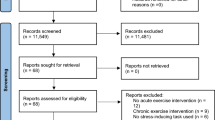Abstract
A stress-muscle hyperactivity-pain (SMP) model has been proposed to explain the etiology of certain musculoskeletal pain disorders. According to this model, subjects should show physiological arousal during periods of stress relative to periods of rest. In a test of this prediction, 31 subjects performed a reaction time task that has been used in previous laboratory studies. Multiple psychophysiological variables were monitored during initial and final 10-minute baselines, during performance on nine 2-minute reaction time tasks, and during 36-second rest intervals following each of the 2-minute tasks. Results showed small but statistically significant differences generally supporting the SMP model when masseter EMG was averaged over time periods of 12 seconds to 2 minutes, but not when masseter EMG was averaged over 10- to 18-minute blocks. These results demonstrated the importance of carefully selecting time intervals for analysis. Additional analyses that compared TMD with symptom-free subjects revealed small differences in EMG that supported the SMP model. Analyses of EMG over shorter time intervals also showed, however, that masseter EMG increased during the 36-second rest interval following performance on a 2-minute stress task; this result suggested that a modification of the SMP model may be necessary.
Similar content being viewed by others
References
Adair, J. G. (1973).The human subject: The social psychology of the psychological experiment (chap. 2). Boston: Little, Brown.
Adair, J. G. (1984). The Hawthorne effect: A reconsideration of the methodological artifact.Journal of Applied Psychology, 69 334–345.
Clark, G. T., & Solberg, W. K. (1977). Clinical diagnosis of dysfunction of the masticatory system. In J. D. Rugh, D. B. Perlis, & R. K. Disraeli (Eds.),Biofeedback in dentistry. Phoenix, AZ: Semantodontics.
Dahlstrom, L., Carlsson, S. G., Gale, E. N., & Jansson, T. G. (1985). Stress-induced muscular activity in mandibular dysfunction: Effects of biofeedback training.Journal of Behavioral Medicine, 8 191–200.
Kirk, R. E. (1982).Experimental design: Procedures of the behavioral sciences (2nd ed.). Belmont, CA: Brooks/Cole.
Kydd, W. L. (1959). Psychosomatic aspects of temporomandibular joint dysfunction.Journal of the American Dental Association, 59 31–44.
Laskin, D. M. (1969). Etiology of the pain-dysfunction syndrome.Journal of the American Dental Association, 79 147–153.
Mercuri, L. G., Olson, R. E., & Laskin, D. M. (1979). The specificity of response to experimental stress in patients with myofascial pain dysfunction syndrome.Journal of Dental Research, 58 1866–1871.
Montgomery, G. T., & Rugh, J. D. (1987). Physiological reactions of patients with TM disorders vs. symptom-free controls on a physical stress task.Journal of Craniomandibular Disorders: Facial and Oral Pain, 1(4), 243–250.
Moss, R. A., Garrett, J., & Chiodo, J. F. (1982). Temporomandibular joint dysfunction and myofascial pain dysfunction syndromes: Parameters, etiology and treatment.Psychological Bulletin, 92 331–346.
Rao, S. M., & Glaros, A. G. (1979). Electromyographic correlates of experimentally induced stress in diurnal bruxists and normals.Journal of Dental Research, 58 1872–1878.
Rugh, J. D., & Solberg, W. K. (1972). Measurement of human oral forces.Behavior Research Methods and Instrumentation, 4 125–128.
Rugh, J. D., & Solberg, W. K. (1976). Psychological implications in temporomandibular pain and dysfunction.Oral Sciences Review, 7 3–30.
Tarler-Benlolo, L. (1978). The role of relaxation in biofeedback training: A critical review of the literature.Psychological Bulletin, 85 727–755.
Yemm, R. (1969). Variations in the electrical activity of the human masseter muscle occurring in association with emotional stress.Archives of Oral Biology, 14 873–878.
Yemm, R. (1976). Neurophysiological studies of temporomandibular joint dysfunction.Oral Science Review, 7 31–53.
Author information
Authors and Affiliations
Additional information
This research was supported in part by Grant 2 S06RR08038-17 funded by the National Institutes of Health.
Rights and permissions
About this article
Cite this article
Montgomery, G.T., Rugh, J.D. Psychophysiological responsivity on a laboratory stress task: Methodological implications for a stress-muscle hyperactivity pain model. Biofeedback and Self-Regulation 15, 121–134 (1990). https://doi.org/10.1007/BF00999143
Issue Date:
DOI: https://doi.org/10.1007/BF00999143




